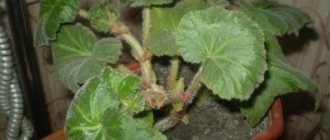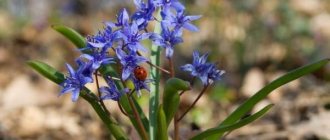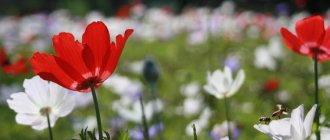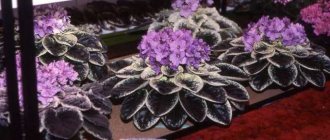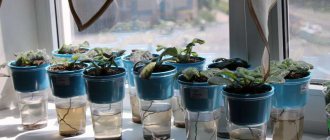The name of the plant anemone (Anemone), or anemone, comes from the Greek word, which means “daughter of the winds.” The fact is that even the slightest gust of wind causes the petals of such a plant to flutter. This herbaceous perennial is a representative of the Buttercup family. In nature, it can be found in regions with temperate climates of both hemispheres, while it prefers to grow in mountainous areas and on plains. There are approximately 160 species that bloom in different ways and at different times, which is why even experienced gardeners often get confused.
Tuber selection rules
When purchasing planting material, you should be interested in its quality, whether it contains instructions, and whether it is treated with fungicides to protect against diseases.
Tubers you should choose:
- without damage,
- with uniform color,
- without black spots and traces of mold,
- with a hard texture to the touch, without voids.
When calculating the required quantity, it should be taken into account that almost out of every five pieces, on average, only one will be viable.
Types and varieties
Anemones for the garden and dacha are:
- tuberous. Rapid growth, however, must strictly follow the rules of preparation and planting, otherwise the plants may die. To enhance germination, the tubers are soaked when the anemone is first planted. If there are already anemones at your summer cottage, then it is enough to divide the tuber into two or three parts for new plants to appear;
- rhizomatous. They reproduce by seeds, are unpretentious in care, tolerate some errors during cultivation well, but it takes a long time for the planting material to transform into adult plants.
Anemones are distinguished by the nature of the petals and layering:
- terry Lord Lieutenant, Everest, Governor, Admiral;
- simple. La Sylphide, Holland, Bride, Mister Fokker.
Anemone species:
- early spring (shade-loving);
- shade-tolerant;
- photophilous.
Anemones are:
- tender;
- crowned;
- delicate blanda;
- European;
- Caucasian;
- sparkling;
- Apennine;
- oak forests;
- buttercups;
- forest;
- Japanese.
Popular anemone varieties:
- Vestal. Terry large inflorescences, white petals.
- Blue shadow. The flowers are soft lavender in color with a pinkish tint.
- Radar. Large flowers, the base is deep pink or red, the center is white.
- Admiral. Double flowers, bright crimson petals.
- September charm. Small inflorescences, the shade of the petals is soft pink.
- Shine. Simple inflorescences with deep red elements.
- Lucy Wood. Spectacular white buds with a delicate purple tint.
On a note! Breeders have created many hybrid varieties (Margaret, Richard Arin, Queen Charlotte) with spectacular shades, double and semi-double inflorescences, and large buds. Many varieties bloom in late summer - early autumn. Hybrid and traditional varieties of anemone are popular among landscape designers for creating compositions and as an independent decorative element.
Landing
Boarding time
Many gardeners are interested in the question of when to plant tuberous anemones?
It depends on how long they expect the buds to open:
- at the end of summer (then planting material is planted directly into the ground when it warms up enough, up to 9-12 degrees);
- in the spring (in this case, planting is done in pots, placing them in a cool place until the optimal temperature is established).
Preparatory work
The ideal planting container is peat pots, in which germinated seedlings are transferred directly into the soil. Pots made from other materials should not be used, as plant roots may be damaged during replanting.
To improve the breathability of the soil, you can add peat, rotted manure, loosen the soil well, adding ash.
Soak
To activate the germination process, it is necessary to perform the soaking procedure:
- add 1-2 drops of one of the root formation stimulants (aloe juice, Zircon) to warm water;
- moisten gauze in this solution and wring it out lightly;
- Roll the tubers with it, cover it with film, and leave it in this position for 5-6 hours.
Landing
The most important aspects of the process of growing tuberous anemones are planting and caring for them.
To better guarantee germination, it is recommended to use a two-step method:
Preliminary germination of the material for 8-12 days (after soaking, the tubers are laid out on slightly moistened soil in a shallow container and covered with film or glass, kept at a temperature of about five degrees Celsius; if there are no sprouts, the soil is easily moistened again).
The appearance of small shoots and roots indicates the time of planting.
Full germination is carried out in pots. Planting depth is 4-5 cm. Plant with sprouts facing up.
Germination in pots
During germination in pots it is important:
- first of all, until the plant is completely rooted, the temperature regime should be observed (about 12 degrees Celsius);
- Water moderately and regularly, avoiding drying out and waterlogging of the soil;
- should not be fed yet.
Description of the plant
Anemone, or anemone, belongs to the ranunculaceae family and has about 150 species. The flower grows in lowland and mountainous areas, is frost-resistant and thrives in temperate climates. Nine plant species live in the Arctic Circle. About 50 species are found in Russia.
Anemones are perennial plants. The different requirements for care are due to the structure of the root system. Flowers with rhizomes are more unpretentious and tolerate cold weather more easily. Varieties with a tuberous root system require more attention from the gardener. Rhizome species include:
- Altai;
- Ural;
- buttercup;
- oak forest;
- blue;
- Udinskaya
The following have a tuberous root system:
- Apennine;
- crowned;
- Caucasian;
- tender;
- garden
Depending on the type, the height of the flowers can be from 10 to 150 cm. Anemone inflorescences are single or collected in a loose semi-umbrella. The color range is very diverse - from delicate white and pink shades to rich red and purple. Species growing in nature have simple single-layer inflorescences with 6–20 petals; cultivated anemones are double and multilayered. The diameter of the flower is from 2 to 8 cm. Anemone reproduces by seeds, rhizomes or tubers.
Different varieties have different flowering periods. Most bloom in May. Autumn anemones are classified as a separate group; their flowering period is from August to October. There are varieties that bloom from July to early September. The inflorescence lives only from one to three weeks.
Depending on the type, anemones grow well on loose fertile, peaty and even poor sandy soils. Most of them need slightly acidic and neutral soils.
Video: anemones in a flowerbed and in a bouquet
Planting conditions on the site
Select a place for landing:
- no drafts;
- well lit;
- with loose, breathable soil;
- with dug up, cleared of weeds, fertile soil with an alkaline reaction.
Flowers should not be placed in damp areas. It is useful to drain planting holes with broken red brick, crushed stone or gravel.
If planting is done in peat pots, then at least 20 cm should be left between them.
If planting is carried out directly in the ground, without germination, a little ash with humus is placed at the bottom of the holes, 12-15 cm deep, and planted with the growth point upward. The distance between the holes is left 20 cm.
Diseases and pests
Anemones in open ground are sometimes attacked by slugs, snails, leaf nematodes, and cutworm caterpillars. Large pests are collected by hand and the greens are sprayed with a solution of metaldehyde. When caterpillars are identified, infected plants and soil are removed, pests are destroyed, and the soil is disposed of.
Causes of diseases:
- weak tubers and mature plants;
- improper watering;
- temperature violation;
- anemones grow next to other crops on which gray rot, various fungal infections have settled, and viral infections develop;
- increased concentration of organic matter and nitrogen fertilizers;
- larvae of worms and insects remain in the soil; weakened plants after the attack of parasites are unable to resist diseases.
In most cases, anemones are used for garden decoration, decorating alpine hills, and there are no beds with vegetable crops in the neighborhood. With this placement of anemones, the risk of viral infections is reduced. With good care and optimal soil moisture, plants rarely get sick, the main problem is attack by pests.
With proper preparation of planting material and studying information about anemone, you can grow luxurious anemones in your summer cottage. It is important to find varieties for which the climatic conditions in the region will be favorable.
More useful information about planting and rules for growing anemones in open ground can be found after watching the video:
How to care for anemones
Watering
Watering frequency: daily (early morning and after sunset). In rainy weather, watering should be reduced.
Remember: waterlogging and drought are harmful to flowers.
Loosening and weeding
It should be remembered that you cannot loosen the soil around the flowers, since their roots are located on the top layer of soil. Weeding is done manually. To control weeds, the soil around the flowers can be covered with a layer of peat or straw.
Feeding plants with fertilizers responds well to their development. However, it should be remembered that fertilizing with fresh manure can greatly damage the flowers.
Despite the apparent difficulty of growing beautiful flowers when you read the article, in practice it is not so difficult and does not take much time. But the little work spent will become a real elixir of health, joy and happiness for you and your loved ones!
Features of cultivation
There are a large number of species and varieties of anemone, some of which are unpretentious to growing conditions, while others, on the contrary, require special care. The thing is that some species are tuberous, while others are rhizomatous. It is the rhizomatous species that are distinguished by their unpretentiousness and ease of care, while the tuberous ones can suffer greatly if they are not cared for correctly. There are several features of growing such a flower that you need to know:
- In dry and very hot weather, they must be watered.
- In autumn, flowers should be fed with complex mineral fertilizers, and before planting and during active growth or flowering, organic matter should be added to the soil.
- To prevent plants from freezing, they should be covered with a layer of fallen leaves in winter.
- The easiest way to propagate this plant is by seeds, which are sown before winter, or by root shoots in spring.
How to grow anemones and ranunculus. Website "Garden World"


